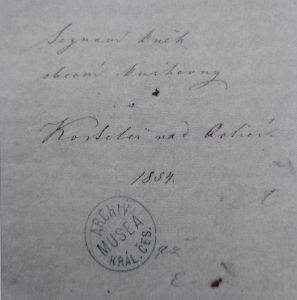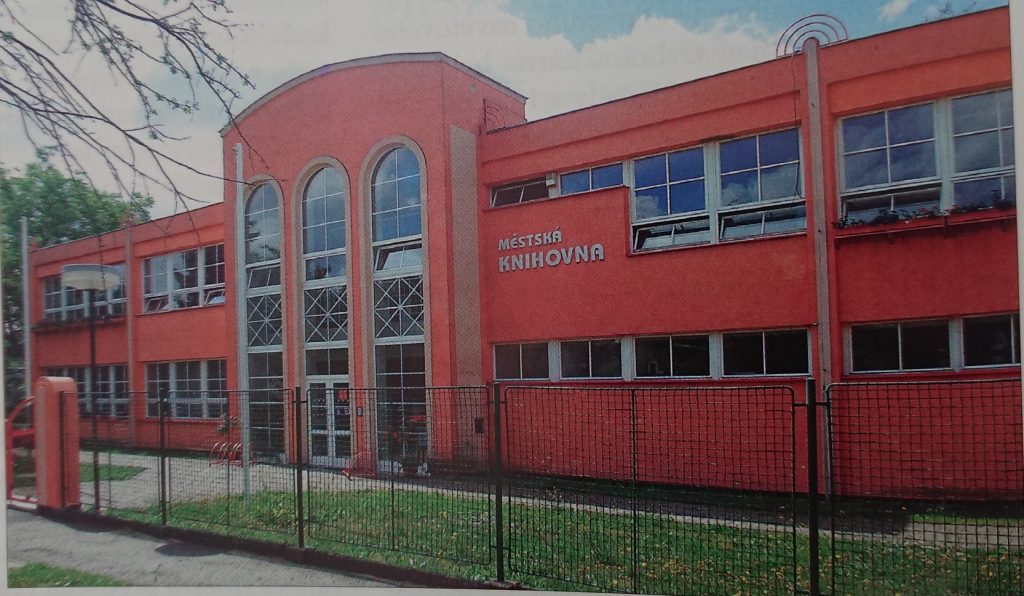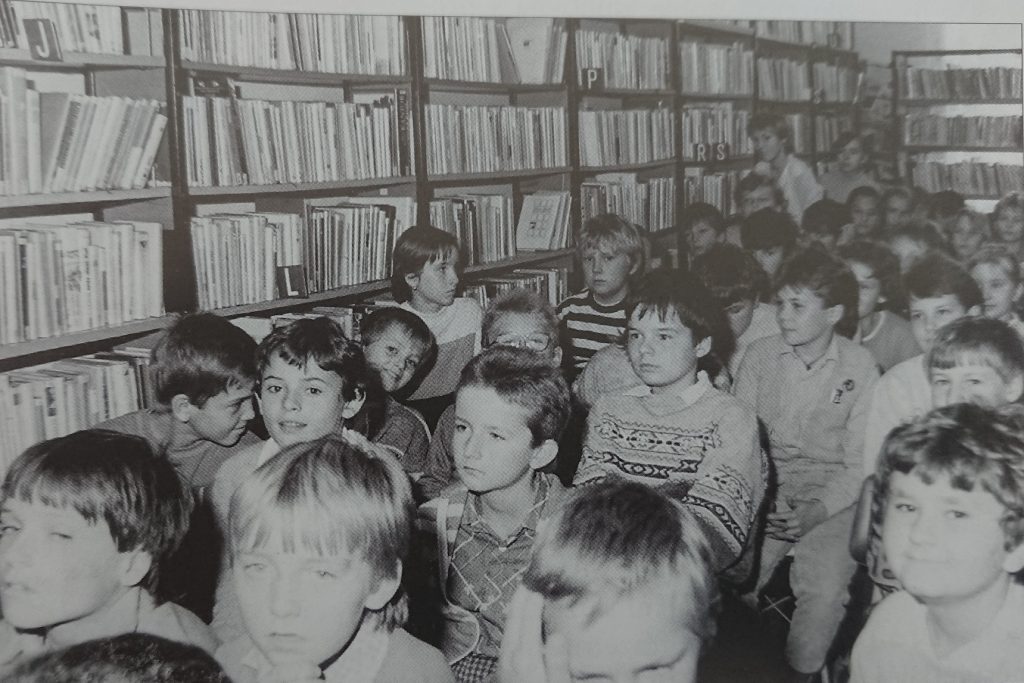Municipal library in Kostelec nad Orlicí
The beginnings of the public library in Kostelec nad Orlicí can be seen in the year 1854. The idea of its establishment was supported by the factory worker Josef Seykora, who donated a considerable amount of money to this facility in the beginning. From that time, the library catalog has been preserved, which contains 334 titles divided into five categories, i.e. religious writings, poems, entertainment writings, youth writings, scientific and non-national writings. 27 titles of newspapers and magazines were displayed in the library’s reading room.

1854, Kostelec nad Orlicí, List of literature of the municipal library in Kostelec nad Orlicí from 1854
Systematic development of the library network only occurred with the establishment of the Educational, later District Enlightenment Corps (OOS) in 1906. When it was founded, the corps set itself the task of opening a public library and reading room at the end of that year, which was to be named Havlíčkova in memory of the fiftieth anniversary of the death of K. H. Borovský. The OOS released 600 K for library activities, preserved books from antiques were to be purchased. The library was supervised by a four-member library board elected on April 20, 1907. From the following overview, it is clear that the spreaders of education were mainly village teachers. A portable public library was set up in Libli, the teaching staff in Čestice asked OOS for help in setting up a public library this year. In December 1908, the first and second public libraries were purchased from B. Kočí worth K320. One was handed over to the municipality of Libel (the library was first opened on March 8, 1908) and the other to Čestice, which began operations on March 15 of that year. OOS turned to the public with a call for donations of quality books read. The call was published in the magazines Posel z Podhoří, Hlas venkova and Osvěta lidu.
Constant difficulties delayed the opening of the public library of the District Enlightenment Corps in Kostelec nad Orlicí. The reading room was opened with the support of the city council in Kostelec nad Orlicí only on February 26, 1911 (there was a general library in addition to this reading room and library), 15 portable bookcases were placed in the local area. In Sudslav, the librarian was placed with the teacher Josef Václavů, in Čestice with the managing teacher Pazourek, in Kostelecké Horky with the mayor Josef Prokop, in Kostelec nad Orlicí – Skála with the treasurer Šváb, in Kostelecká Lhota with the teacher Josef Ešpander, in Libli with the managing teacher Josef Pejš, in Ličné with the teacher Kodytek, in Nová Ves with the teacher Martínek, in Proruby with teacher Koutník, in Hřibiny with Anna Koťanová, in Velká Skrovnice with the head teacher Josef Čižinský, in Synkov with the farmer Václav Plašil, in Tutleky with František Petrlák, in Voděrady with the head teacher Matějka and in Žďár nad Orlicí with the head teacher Václav Macháček. These fifteen bookcases contained 825 volumes, each reader borrowed about ten books on average. During 1910, four more bookcases worth 624 K were placed at Václav Ondráček’s in Koldín, at the miller Josef Fikejs’s in Velká Ledská, Josef Kapucián’s in Lípa, and the last one in Šachov.
With the creation of Czechoslovakia, it was necessary to adjust the activities of some public facilities. This also applied to public librarianship, as “public libraries were an important and almost the only means from which citizens could obtain education.” According to Act No. 607 Coll. From July 22, 1919, on public libraries, municipalities were obliged to establish their own public libraries by the end of December 1920 and to pay for their operation from their budget to the value of at least 60 halers per person per year, the law set the lowest annual additions in the range of 50 bound volumes, and a library board had to be elected. The activities of the libraries were supervised by a “state library instructor” appointed by the Ministry of Education and National Education (hereafter MŠANO). When establishing the public library, the Municipal Office in Kostelec nad Orlicí called on the local associations owning the libraries to hand them over to the public people’s library. The local Catholic Unity rejected this. In a letter dated March 3, 1920, the chairman of the union told him that their library had been fulfilling its function for over 25 years and that he himself was not entitled to freely dispose of the books. The chairman of the library board of the municipal library in Kostelec nad Orlicí in 1920 was František Granát, manager and at the same time librarian Antonín Güttner. The district education corps was obliged to hand over the management of its library (a total of 501 volumes) to the city. In 1921, there were 339 volumes and 92 titles of newspapers and magazines in the library, in 1922 there were already 501 volumes, and 289 readers honored the library with their visit, borrowing a total of 2,474 books. The annual income of the library was 2,989.68 CZK, the expenses reached the same amount. The most was paid for the regular operation of the facility – CZK 1,938.28, CZK 500 was the librarian’s annual salary, CZK 305.40 was the cost of binding and repairing books, and CZK 178 was used to buy new books. Since 1920, the city was supposed to contribute the legal amount of at least CZK 3,012 per year to the library, but as it was discovered during an inspection in 1923, it did not do so. This fact was pointed out in October 1923 by a state library instructor, who learned that the municipal authority not only did not pay the mandatory contribution in the appropriate amount of CZK 3,005.40, but even retained the largest part of it as compensation for the rent for the room. Therefore, the municipality had to reimburse the library for what was shortened due to an erroneous interpretation of the law, and next time pay this contribution in accordance with Act No. 212 Coll. Dated June 9, 1921, in cash to the Treasurer of the Library Board. As early as 1931, the reading room was supposed to move to the new building of the municipal savings bank, but it had not yet been completed at that time, so it had to be located in a temporary room. In this year, 1,849 volumes were on the shelves of the public library, 3,698 books were lent to 207 patrons. The library board was composed of the chairman František Granát, director of the real estate, treasurer Karel Marek, druggist, manager Antonín Güttner, senior teacher, librarian Alois Felcman, director of the general and burgher boys’ school, and board member Jan Andrle, businessman.
On September 26, 1940, the district education corps established a district library board in Kostelec nad Orlicí. Václav Beneš, managing teacher in Tutleky, was entrusted with its management, Miroslava Hrušková, a teacher in Kostelec nad Orlicí Na Skále, became the manager and librarian, Jan Janský, a teacher in Kostelec nad Orlicí, treasurer, Josef Lanta, professor of science, and Bedřich Moravec, managing teacher in Kostelecká Lhota, were members of the committee. According to the resolution of the OOS, the District Drtin library was to be connected with the District Traveling Library, which was currently located in an unheated room of the city museum in Kostelec nad Orlicí, and MŠANO was asked for a financial contribution to its administration and activities. In 1941, it sent a contribution of 660 K and books for 1,115 K. The revision of both libraries was carried out in the summer of 1942, 105 books were missing from Drtin’s library, badly damaged or incomplete volumes were discarded, objectionable titles marked with censorship were sent to the District Office in Rychnov nad Kněžnou. Traveling lockers (17 in total) were inspected, damaged locks were repaired, the library was moved to Na Skále school. However, within a fortnight the Na Skále school was moved with the library to the building of the real gymnasium, at the end of the 1942 vacation, the library moved back to an unheated and damp room in the city museum. All public library librarians have received district library book lists. The library was also financially supported by the District Savings Bank and the Municipal Savings Bank. The MŠANO decree of August 20, 1943 established the office of municipal library clerk, who handled all files related to public librarianship. Antonín Svoboda, a teacher from Vysoké Mýt, was appointed municipal library officer, in whose hands all members of the library council had to make a pledge.
On April 11, 1974, the library board of the state supplementary library in Rychnov nad Kněžnou was established, whose chairman was MUDr. Karel Klícha, vice-chairman Josef Mojžíš, chairman of ORO and parish priest of the Czechoslovak Church in Vamberk, manager Ladislav Škop, district library inspector, librarian Miroslava Hrušková, managing teacher of the rock school in Kostelec nad Orlicí. The district supplementary library in Kostelec nad Orlicí Na Skále had to be moved to Rychnov nad Kněžnou according to the order of the Ministry of Education and Culture dated September 2, 1946, but no suitable rooms were provided for it, and it was also expelled from the room in the Na Skále school. It was stated that the entire library is already on loan to the border area of the Žamber district for the second year, and since additional libraries have already been established in these districts, it should return to its location in Rychnov due to the weak interest of readers.
As early as 1954, the location of the public library in Kostelec nad Orlicí was very unsatisfactory, so the educational meeting requested the release of two large rooms in the administrative building and the furniture warehouse of the Unity. After the liberation of Rabštejn by the military garrison, it was to be moved to two rooms in Rabštejn in the fall of 1954. From there it moved to the MNV premises at the end of 1958. Interest in the library’s services grew, and by that year it already had 700 patrons and 20,000 volumes. The head of the library was Anna Nováková. In 1965, 9,000 volumes sat on the library shelves.
Until November 1995, the library was located in the premises of the municipal office, from where it moved to a new building in Krupková Street No. 1154, the doors of which opened to the public on December 1, 1995. The logo for the library was created by Vladimír Komárek, who exhibited his works in Kostelec nad Orlicí in the gallery of the Růže cafe and in the library, talked with readers and liked to visit his friends here i.

The library building in Krupková Street No. 1154
In 2001, the local library registered 1,067 regular readers, 10,811 visitors visited it, and 41,353 books were borrowed. 32,861 volumes, 62 titles of newspapers and magazines were available to readers. The library is also visited by fellow citizens with visual impairments, who use the option of borrowing audio books through the interlibrary loan service. The operation of the library and the purchase of books is paid for from the city budget, other funds from grants went to the development of informatics. In connection with the establishment of an Internet workplace, the Municipal Library in Kostelec nad Orlicí has offered basic training in working with a personal computer (PC) and the Internet since March 2002. This year, three PCs connected to the Internet were available to users. On behalf of the Ministry of Culture, the Municipal Library in Kostelec methodically manages and financially secures 22 municipal libraries. The public library currently has five full-time and one part-time staff. It provides library, bibliographic and information services, runs an exhibition hall, provides cultural and educational services.
City Library Directors:
Ludmila Kopecká (1968-1978)
Jiřina Vrbová (1978-1979)
Lenka Libotovská (1979-1981)
Milada Jelínková (1981-2002)
Iva Havlová (2002-present)
The church library has its share in the social and cultural life of the city. It prepares literary programs, artists’ exhibitions and talks with prominent personalities of the cultural world.
